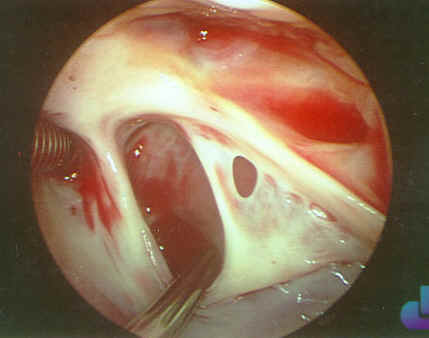- What is Atrial Septal Defect (ASD, Ostium Secundum Defect)
- Statistics on Atrial Septal Defect (ASD, Ostium Secundum Defect)
- Risk Factors for Atrial Septal Defect (ASD, Ostium Secundum Defect)
- Progression of Atrial Septal Defect (ASD, Ostium Secundum Defect)
- Symptoms of Atrial Septal Defect (ASD, Ostium Secundum Defect)
- Clinical Examination of Atrial Septal Defect (ASD, Ostium Secundum Defect)
- How is Atrial Septal Defect (ASD, Ostium Secundum Defect) Diagnosed?
- Prognosis of Atrial Septal Defect (ASD, Ostium Secundum Defect)
- How is Atrial Septal Defect (ASD, Ostium Secundum Defect) Treated?
- Atrial Septal Defect (ASD, Ostium Secundum Defect) References
What is Atrial Septal Defect (ASD, Ostium Secundum Defect)
Atrial septal defect (ASD) is a congenital heart defect. In foetal circulation there is normally an opening between the two atria (the upper chambers of the heart) to allow blood to bypass the lungs. This opening usually closes about the time the baby is born. If the opening is persistent it is called an ASD, and thus blood continues to bypass the lungs. This is called a shunt.
There are generally three types of ASD:
- Ostium primum atrial septal defect: Occurs when there is interference with the development of the septum primum at its lower margin, associated with abnormal development of the endocardial cushions – there is no inferior rim of atrial septal tissue. This defect is associated with abnormalities of the mitral and tricuspid valves as well as abnormalities of the upper portion of the interventricular septum.
- Ostium secundum defect: Located in the central portion of the atrial septum, related to the foramen ovale. It results from the inadequate closure of the central hole in the septum primum by the septum secundum – this also produces the fossa ovalis defect. This is the most common form of ASD.
- Sinus venosus defect: In the superior portion of the atrial septum which generally extends into the superior vena cava.
Statistics on Atrial Septal Defect (ASD, Ostium Secundum Defect)
About 1 in 2,000 live births. Females outnumber males 3:1 in incidence.
Risk Factors for Atrial Septal Defect (ASD, Ostium Secundum Defect)
The aetiology of congenital heart defects is not understood but several factors are known to be associated:
- Maternal drug abuse, alcohol abuse and radiation exposure;
- Maternal infection, particularly rubella;
- Genetic abnormalities;
- Chromosomal abnormalities (septal defects are associated with Trisomy 21- Down’s syndrome).
Progression of Atrial Septal Defect (ASD, Ostium Secundum Defect)
ASDs may occur in isolation or may be associated with other malformations:
- Spontaneous closure of ASDs is rare after the first 2 years of life;
- ASDs allow shunting of blood from one side of the circulation to the other. There are no great pressure differentials across the two atria and shunting is usually from left to right due to the greater compliance of the right heart chambers. Flow rates across the defect are usually not high;
- Increased flow to the pulmonary circulation eventually leads to pulmonary hypertension, usually by the 4th decade. Atrial arrhythmias, particularly AF are common due to the physical distention of the atria;
- In severe cases the shunt can eventually reverse so that blood bypasses the lungs – this is termed Eisenmenger’s syndrome and is a poor prognostic factor.
Symptoms of Atrial Septal Defect (ASD, Ostium Secundum Defect)
- Most are asymptomatic until later in life;
- Susceptibility to chest infections is common;
- Subtle failure to thrive may occur in some children;
- Exertional dyspnoea (shortness of breath) and weakness are sometimes reported;
- Later in life, palpatations associated with AF and congestive heart failure are common with exertional dyspnoea and orthopnoea.
How is Atrial Septal Defect (ASD, Ostium Secundum Defect) Diagnosed?
Chest x-ray: Prominent pulmonary vasculature may be seen. Right ventricular hypertrophy may be seen.
ECG: May show some right bundle branch block and right axis deviation.
Prognosis of Atrial Septal Defect (ASD, Ostium Secundum Defect)
Most commonly symptoms dont develop until the twenties when evidence of pulmonary vascular disease becomes apparent. With increasing age, risk of developing cardiac rhythm disturbances increases. By the age of 40 most patients are severely symptomatic. Cardiac failure is the most common cause of death. Others include emboli and infections.
How is Atrial Septal Defect (ASD, Ostium Secundum Defect) Treated?
Large ASDs (where pulmonary blood flow is greater than 150% normal) should be repaired surgically as early as possible, preferably before 10 years. The outlook is good if pulmonary hypertension (high blood pressure in the lungs) has not developed. Otherwise, medical management of heart failure and other complications such as arrhythmias should be instigated.
Atrial Septal Defect (ASD, Ostium Secundum Defect) References
- Anderson RH. Paediatric Cardiology. New York, NY: Churchill Livingstone; 1987. Book
- Behrman RE, Kliegman R, Jenson HB, et al. Nelson Textbook of Pediatrics (17th edition). Philadelphia: Saunders; 2004. Book
- Schlant RC, Alexander RW, Fuster V (eds). Hurst’s The Heart (8th edition). New York, NY: McGraw-Hill; 1994. Book
- Kumar P, Clark M (eds). Clinical Medicine (4th edition). Edinburgh: WB Saunders Company; 1998. Book
- Rudolph CD, Rudolph AM, Hostetter MK, et al. Rudolph’s Pediatrics (21st edition). New York, NY: McGraw-Hill; 2003. Book
All content and media on the HealthEngine Blog is created and published online for informational purposes only. It is not intended to be a substitute for professional medical advice and should not be relied on as health or personal advice. Always seek the guidance of your doctor or other qualified health professional with any questions you may have regarding your health or a medical condition. Never disregard the advice of a medical professional, or delay in seeking it because of something you have read on this Website. If you think you may have a medical emergency, call your doctor, go to the nearest hospital emergency department, or call the emergency services immediately.








